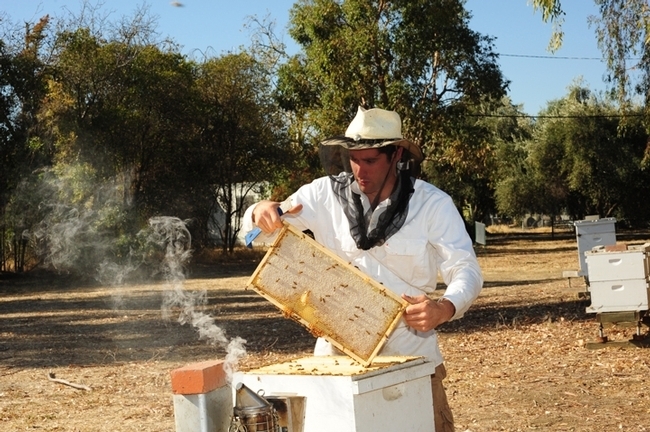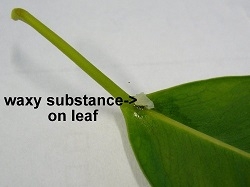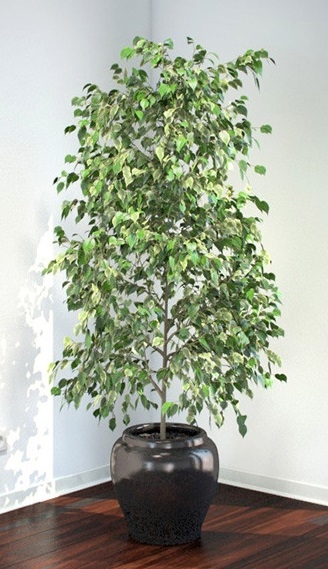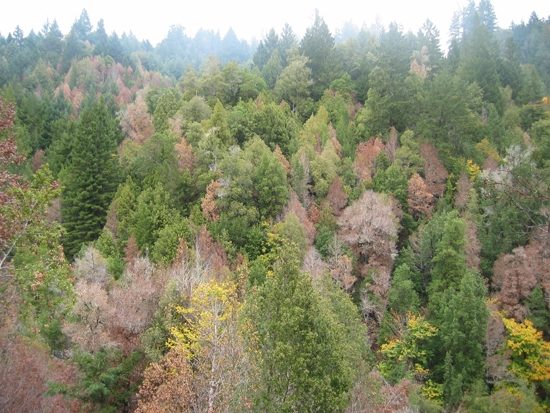From the UC Blogosphere...
Those Finicky Ficus!!!
Advice from the Master Gardeners of Contra Costa's Help Desk
The Client's Concerns and Requests:
Response from the MGCC Help Desk:
Thanks for bringing the Ficus benjamina (Weeping Fig) leaf samples and photos into the MGCC office this morning. Having a sample made it easy to see the white sticky globs at the base of each leaf. When we looked at the leaf under the microscope, there were no insects present on the leaf or under the white waxy substance. We also looked at another Ficus growing in our office and found that it, too, had the same white sticky globules on the base of each leaf.
After further research, we discovered that there are several cultivars of Ficus benjamina which have a dark black “wax” or “phenolic” gland at the base of each leaf which secretes latex to attract fig wasps that pollinate the tree in nature. The white substance you are seeing is a latex leakage which crystallizes when exposed to air. The reproductive systems of species in the genus Ficus are unique. A University of Hawaii article on Ficus benjamina explains that each species of Ficus has an associated species of agaonid wasp and pollination can only occur when that specific wasp is present. Your plant is trying to attract a tiny little pollinator wasp which in all probability has not been introduced to our area. I don't believe that the white substance you have is anything to worry about. If you are concerned about the aesthetics of the white spots, you might try wiping and/or washing them off. Curiously I noticed that the heat of the microsope caused them to liquefy and drip off! For more information on the special leaf gland on some Ficus cultivars, see the University of Florida article http://hortsci.ashspublications.org/content/34/6/1051.full.pdf.
You also mentioned that you might also have a sticky substance in the middle of the lower surface of some of the leaves. If these are in locations where they wouldn't be a drip from the leaf gland of possibly a nearby leaf, it is possible that you might have scale or another sucking insect. As I mentioned, we didn't see anything under the microscope. You might want to examine your leaves, and contact us if you do see any signs of scale or other insect. (Although not a UC guidance document, the UC references cited in the article on Ficus Benjamina Pests” at http://homeguides.sfgate.com/ficus-benjamina-pests-40044.html would be the primary UC guidance MGCC would use to determine appropriate care if there were pests on your Ficus.)
Ficus are notoriously finicky about water, light, and transplanting. From the picture you provided, it looks like you have a nice light filled location for your tree. Because the back corner is dark, it is a good idea to frequently rotate the pot. You mentioned that some of the leaves are turning yellow. Yellowing leaves can be a sign that it is either getting too much or not enough water. (We did mention that Ficus are finicky?) You said that you water your plant once a month, just until runoff, and that the roots are “tight”. It may be that the root ball is very compacted and not able to take up enough water because the water is quickly running through the pot. One method of helping to get the root ball to take up water we would propose would be that several times a year when you water the plant, completely submerse the pot in a tub, bucket or pot of water. Leave it for several hours, giving the rootball a change to become fully saturated. You will want to drain off any free flowing water when you remove your plant from the tub/bucket/pot. After that continue watering as usual.
Regarding repotting, check the roots of your Ficus tree to determine if/when it is time to repot the Ficus. If the pot appears crowded with roots and there is little soil left, your Ficus has probably become root-bound and needs to be repotted. When repotting, after removing the tree from the pot, brush the soil away from the root ball to assess how badly root-bound the Ficus has become. If some of the roots have begun to circle around the ball, carefully unwind them with your fingers. Gently separate the roots in the root ball, releasing any dirt that may have been clogging it. Cut off any dead or rotten roots using a small pair of gardening scissors or pruning shears. If any of the roots have begun to grow through the drainage hole in the pot, prune these back as well. Select a new pot that is 1 or 2 inches wider in diameter than the old pot. Fill the bottom with several inches of fresh potting soil, place the tree into the pot, and backfill with new potting soil to cover the roots and stabilize the tree. Often when their environment is changed, whether a change in water, light, rotating the plant, or transplanting there is a chance the Ficus will drop its leaves - but in time they should grow back.
Feel free to contact us if you have any additional questions.
Happy gardening with a great indoor plant.
Master Gardeners of Contra Costa's Help Desk
Note: The Master Gardeners of Contra Costa's Help Desk is available year-round to answer your gardening questions. Except for a few holidays, we're open every week, Monday through Thursday for walk-ins from 9:00 am to Noon at 75 Santa Barbara Road, 2d Floor, Pleasant Hill, CA 94523. We can also be reached via telephone: (925) 646-6586, email: ccmg@ucanr.edu, or on the web at http://ccmg.ucanr.edu/Ask_Us/
Tomato Workshop
Tomato Workshop By Leonard Cicerello UCCE Master Gardener What can I do...
Billy Synk: Director of PAm's Pollination Programs
It's National Pollinator Week and there's exciting news on the horizon. Staff research associate Billy Synk of the Harry H....

Former UC Davis staff research associate/beekeeper Billy Synk, shown in the apiary of the Harry H. Laidlaw Jr. Honey Bee Research Facility, has been named the director of Pollination Programs for Project Apis m. (Photo by Kathy Keatley Garvey)
Avocado Growers Revisit Pruning Techniques
California Avocado Growers Seminar Series is a lecture series presented by the California Avocado Society, Inc., California...

20150604 140708 (1)
Sudden oak death still a threat and still spreading
Thirteen years after sudden oak death was first detected in California, the disease's range in northern coastal areas of California and southwest Oregon continues to grow, according to a report by Michael Joyce on Jefferson Public Radio.
Joyce interviewed Yana Valachovic, a forest advisor for UC Agriculture and Natural Resources in Humboldt and Del Norte counties. Valachovic is also director of the UC ANR Cooperative Extension offices in Humboldt and Del Norte.
"For me, the challenge is communicating to the public the disease has not gone away; in fact, it's actually getting substantially worse," Valachovic said.
Sudden oak death is caused by the pathogen Phytophthora ramorum. Currently less than 2 percent of Humboldt County's 2.25 million acres of forest are impacted by sudden oak death. But the average annual rate of expansion per year is 3,500 acres, Valachovic said. One challenge related to containing the disease is the structure of California forest agencies.
"The wildlands of California don't have a single agency that's responsible for controlling invasive introductions," she said. "Secondarily, there is no funding source that is set aside to manage these kind of epidemics. And so everything is piecemealed together: piecemealed responsibility, piecemealed in funding to address these issues."
Furthermore, Forest Service funds can only be used for monitoring, containment and education.
Joyce concluded the story with a question: "How will we learn more about this disease that is spreading through our forests at a clip of about 5 miles per year?"
Read more about sudden oak death on the California Oak Mortality Task Force website.











